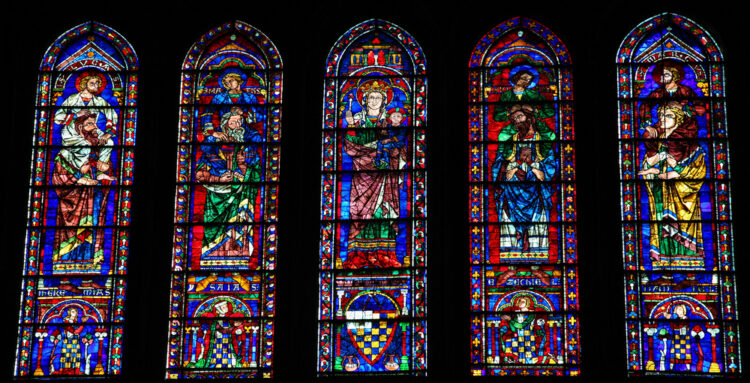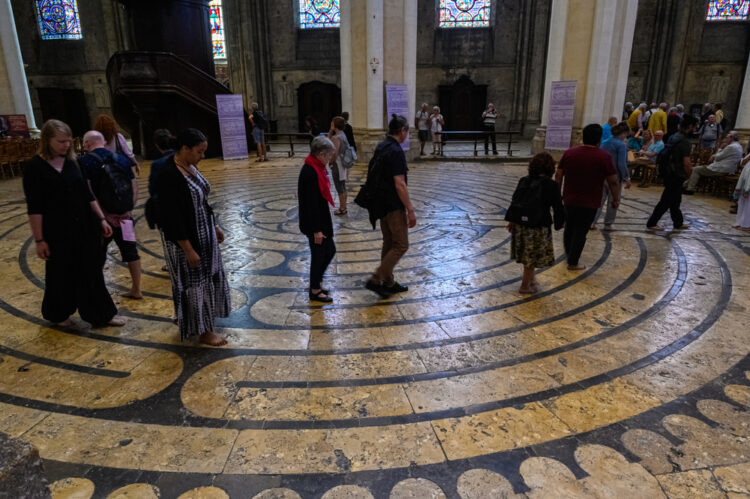Initially constructed in 1145 and later reconstructed over a span of 26 years following a fire in 1194, Chartres Cathedral stands as a pinnacle of French Gothic artistry. Situated in the Centre-Val-de-Loire region, Notre-Dame de Chartres Cathedral represents one of the most genuine and comprehensive specimens of early 13th-century religious architecture.
Chartres Cathedral, officially known as the Cathedral of Our Lady of Chartres, is one of the finest examples of Gothic architecture in the world. The cathedral’s stained-glass windows, which cover an area of over 2,600 square meters, depict a wide range of biblical scenes and saints.

The architecture of Chartres Cathedral is characterized by its soaring vaults, pointed arches, and flying buttresses, all hallmarks of the Gothic style. The cathedral’s west facade, with its three ornate portals and rows of sculpted figures, is particularly impressive, showcasing the skill and artistry of the medieval craftsmen.
Among the Cathedral’s many marvels, the labyrinth embedded in the its floor has captured the imagination of visitors for centuries. This intricate pathway, measuring nearly 13 meters in diameter, is more than just a decorative element; it is a powerful symbol of the spiritual journey.
 A labyrinth is a complex, circuitous path that leads from an outer edge to a central point. Unlike a maze, which is designed to confuse and challenge with multiple paths and dead ends, a labyrinth has a single, unambiguous route to the center. The path is often lined with intricate patterns and symbols, adding to its visual appeal and symbolic significance.
A labyrinth is a complex, circuitous path that leads from an outer edge to a central point. Unlike a maze, which is designed to confuse and challenge with multiple paths and dead ends, a labyrinth has a single, unambiguous route to the center. The path is often lined with intricate patterns and symbols, adding to its visual appeal and symbolic significance.
Labyrinths have been found in various cultures throughout history, dating back to ancient times. They have been used for a variety of purposes, including religious rituals, meditation, and even as a form of entertainment. In the Christian tradition, labyrinths have come to symbolize the spiritual journey of the believer, with the winding path representing the challenges and obstacles one must overcome to reach a deeper connection with God.
In Greek mythology, the labyrinth was famously associated with the Minotaur, a half-man, half-bull creature that was imprisoned in a labyrinth built by Daedalus. The hero Theseus navigated the labyrinth and slayed the Minotaur, a tale that has been interpreted as a metaphor for confronting and overcoming one’s inner demons.
In Native American cultures, labyrinths were often used in healing rituals and as a means of connecting with the spirit world. The Hopi people, for example, used labyrinths in their kiva ceremonies, which were designed to bring balance and harmony to the community.
The labyrinth at Chartres Cathedral is a classic example of a medieval labyrinth, with its 11 concentric circles and 34 turns. The path is divided into four quadrants, each representing one of the four gospels of the New Testament. As the walker navigates the labyrinth, they are symbolically following in the footsteps of Christ, experiencing his journey from birth to death and ultimately, to resurrection.

The center of the labyrinth is often seen as a representation of the divine, the ultimate goal of the spiritual journey. Once the walker reaches the center, they are encouraged to pause and reflect, to bask in the presence of the divine and to receive the blessings and insights that come with this connection. The journey out of the labyrinth is seen as a return to the world, armed with new wisdom and a renewed sense of purpose.


